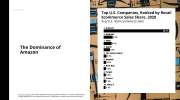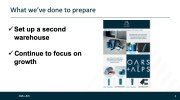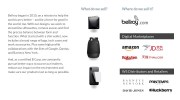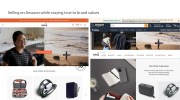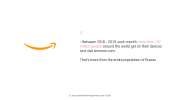
The current crisis has been a gamechanger for e-commerce. With many people stuck at home and unable to get out, e-commerce acceleration has been one of the big stories in retail. And even within that, the undisputed winner is Amazon.
Deep Dives: Amazon Strategies is a survival guide packed with of videos, presenter’s decks and key takeaways from our Amazon Strategies Virtual Forum that provides valuable insights and practical tips in order to help you grow your business.
State of the industry
Amazon was always going to dominate the space. The company was already estimated to have 37.3% of the U.S. market share in 2020, according to eMarketer. But following the bump in e-commerce sales during the pandemic, that prediction has increased to the company owning 38.7% of the market. By next year, the market research company is predicting that Amazon will be at 39.7%.
Everyone knew dominance was coming. Nobody thought it would happen this quickly.
Amazon’s dominance is coming fast and is being accelerated by the pandemic. Whether or not you want to be on the platform, it may be your only defense to protecting your brand and growing your e-commerce platform.
More people than ever before are shopping online. According to a survey conducted by the Cleveland Research Company, as of March 25, 52% of consumers reported that they have shifted the biggest portion of their online purchases to Amazon.
For the brands that have delayed the inevitable, now is the time to figure out exactly how to get your brand in front of these customers, especially those who are Amazon loyalists, as well as secure and authenticate your presence in a crowded marketplace.
For other brands, who have been on Amazon for a while, if their products are not what the platform deems “essential,” they have been de-prioritized in Amazon’s fulfillment operations as of March 17, and now have to figure out what that means for their business as well as their marketing strategy on the platform.
From April 1 to 15, essential products have averaged a 161% increase in sales over the same period last year, while non-essential products experienced an average increase of 15% during that period. The non-essential product category previously was down 12% in March year over year, denoting a trend of consumers panic buying essential products during the pandemic, which is now slowing down.
Amazon is still struggling with its fulfillment and brands are struggling with keeping up inventory, however for the brands with inventory, 77% of advertisers of essential products are increasing or maintaining their ad spend in April while 60% of non-essential product advertisers are doing the same. But for those advertisers who are limited in inventory, now is the time to become competitive in upper funnel brand advertising on the platform.
During the week of April 19, Amazon’s year over year growth reached nearly 100% — a sharp increase from 45% during the week of April 12 — in terms of consumer spend on the platform, according to consumer spending data company Facteus. The marketplace’s year over year growth held steady between 20% and 40% during the month of March.
“Amazon is a defense mechanism and an offensive move is to take back some of the share of the market,” said Mark Wynohradnyk, brand director at Gravity Products, a DTC company that has become multi-channel.
During the first-ever Digiday Amazon Strategies Virtual Forum, brands, marketers and major players in the Amazon retail ecosystem discussed not only how they went about owning close to 100% of their buy box, but also why it was crucial for them to come onto the platform in the first place.
Here’s what you need to know.
Using Amazon as a defense mechanism
Despite being told that using Amazon as a sales channel would ruin its brand, luxury men’s skincare company Oars + Alps’ decided that not being on the platform would be just as detrimental. Amazon is not only the number one channel for men to shop on — so it made sense to be where the customers are — but not being on the platform meant that other third-party retailers could sell Oars + Alps’ products.
Designer wallet and bag brand Bellroy was in a similar position of not thinking that Amazon was the right channel for its business. In 2013, however, COO Lina Calabria started seeing some of its retail partners buying up large quantities of product beyond their store’s capabilities to sell. She knew that they were creating their own Amazon retail strategy around Bellroy’s product and were selling to customers who wanted to be on that platform. “We didn’t have a choice,” she said.
To take back control of its brand, in 2013, Bellroy joined Amazon, three years after launching. And in 2018, a year after launching, Oars + Alps joined the marketplace.
- “Your brand is on Amazon in one shape or form,” said Taylor Hamilton CEO of reCommerce. If you’re not the one controlling your presence then not only are you losing control of where that money is going, but you’re losing control of your brand image in the process.
- Calabria did not want Bellroy on Amazon but she said that she could not ignore the complaints about the service that customers were giving those retailers. The customers wanted to be on that platform and buy from Amazon, but not being on the platform themselves meant that they couldn’t control the experience.
- Having as close to 100% of buy box ownership enables brands to have more control over capturing sales. Oars + Alps CMO Laura Cox said that this enabled her company to also have total control over product reviews, product description content and customer service. And by entering into the gated category of “luxury beauty,” the brand was able to prevent any other merchants from selling its products.
Building brand consistency on Amazon
Brand consistency can mean keeping the same imagery running from a DTC site to the Amazon store front, or it can mean upholding the same brand values.
For Ekta Chopra, vp of digital at E.L.F. Cosmetics, being on Amazon, despite it not being a top channel for sales for the company, maintaining brand consistency in appearance was crucial.
And once Bellroy joined the platform, Calabria said that it was important to maintain the tone of the brand and create clear lines from its DTC site, its retail presence and its Amazon presence. She said it was really important to her team to not “train customers to go to Amazon for a discount or hunt around for a bargain,” as discounting is not core to the brand’s sales strategy.
- “We don’t care if they walk into Walmart or go on Walmart.com,” said Chopra. Regardless of the channel, she said that all promos, content and brand elements are consistent, which goes the same for its Amazon Storefront.
- Staying true to not discounting, part of what Bellroy had to do was to control those third-party sellers. And in the meantime while you’re working to prevent other third-party retailers from selling your product, don’t get swept up in Amazon’s promotion of the best priced merchant being the primary option in the buy box. Keep your prices consistent from channel to channel.
- The only day that Bellroy allows promotions is Black Friday because it is a day where its retailer partners are also comfortable with offering discounts on specific products. Amazon Prime Day is not really the same case. Retailers are hesitant to participate along with those discounts, so Calabria said that only a select few outgoing styles were included in the Prime Day promotion.
The argument for not being on Amazon
Luxury sports bag brand was briefly on Amazon for just about a year before deciding that the trade offs to the brand were just not worth the effort.
CEO Aaron Luo said that the platform initially pulled him in with statistics like using fulfilled by Amazon capabilities gives sellers a 30-50% increase in sales, and 90% of U.S. consumers go to Amazon to search for products that they’ve seen on another site. So in 2018, he started testing selling older, past season products on Amazon. This did not yield as good results as his team initially thought and decided that putting any more product onto the platform would not make the returns any better.
“Ultimately, we felt that in order to tell the story from start to end, we really needed the supply chain to be fully integrated and not chance not meeting our goals,” Luo said.
Before leaving the platform, Luo suggests considering a few key things:
- What is your product category? For Caraa, the type of products the company has do not compete on value or pricing, so a marketplace that focuses a great deal on those category tools did not make sense for the brand.
- What is your value proposition? “ If you are telling customers to pay a premium, you need a platform to tell the story,” Luo said. The Amazon product pages, he felt, did not give the brand enough control over that element.
- How important is vertical integration to your company? Vertical integration was key to Caraa because being able to own everything down to the last mile of packaging and post communication gives the company full control over the customer base.
How to create an effective product page
Gravity Products launched on Kickstarter in 2017 with its weighted blanket and soon enough, the term “gravity blanket” became synonymous with the physical weighted blanket, according to Mark Wynohradnyk, brand director at Gravity Products. While the company itself was not on Amazon, similar products began popping up on the platform and used the company’s name and intellectual property within its titles and descriptions, naturally leading to confusion over the product and whether or not it was coming from the Gravity brand itself.
Gravity eventually came onto the marketplace to regain its IP and trademarks, but learned in the process that keywords within titles and descriptions are crucial to operating effectively on Amazon. Beyond that though, the Amazon product page is essentially an extension of your brand, so it needs to be designed in a way that fully illustrates the benefits and the unique value proposition of the product you are trying to sell.
- Get the title and description right. Like the brands using “gravity” in their product titles, you want to include the product name, a simple description and some details around color, weight and size, depending on the key identifiers of your item. In the description, there is no word limit per bullet, but don’t use word for word company from your website. Make it easily digestible and use all caps to make a feature stand out.
- Depict your product in good images and videos. A product on white background is mandatory for the first image, but after that, use the remaining eight spots for whatever you want as long as it’s high resolution. Wynohradnyk suggests using lifestyle images to show how the consumer will use it in their daily life. Then text within images helps to tell the story and reiterate the biggest points from the description. Lastly, videos can be used to explain the features that can’t be well contextualized or shown in a single image.
- Tell your brand story in the A+ Content section. Use all available real estate and make sure to hammer home key messages. This is the space to fit context that you couldn’t include above.
How to maximize your advertising strategy on the platform
Launching an advertising strategy on Amazon is not only very complicated, but it is very complex.
Mark Power, CEO of Amazon marketing services company Podean, said that for his newly formed clients, one-third of their investment goes towards creating the product and one-third goes towards investing in Amazon and building the brand’s presence on the marketplace. The final one-third needs to be allocated to a marketing and media strategy on Amazon in order to make sure that you’re building your demand on the platform.
“In your first period, don’t expect big profits from Amazon,” said Power. “It’s a platform that you need to invest in” before you start making any headway in terms of revenue. On the other hand, if you aren’t investing anything into your Amazon marketing strategy, but you are investing a significant amount of your budget into your DTC site and promotion, you’re going to leave out a significant portion of your potential customer base who are channel loyalists.
- There are three types of ads that run on Amazon. Top of search (on the first page), rest of search (can come up anywhere within a search page below the fold) and product page placement (on a product page, as the name suggests, but can have dozens of products listed).
- The “top of search” category has the highest conversion rate for sales on the products that are featured in those spots. “Rest of page” category is second in terms of conversions and the “product page” category has a low conversion rate — it gets about 50% of the clicks driven by advertising, however, so it has merit for building brand awareness.
- The time of the week also impacts the performance of ads, and therefore, where you should be putting the bulk of your bids. On weekends, consumers have more time to research products so they’re going to take longer before making a purchase. On the weekdays, however, “top of search” ads outperform the other ad types significantly.
Now is the time to be competitive with advertising
Amazon began prioritizing the fulfillment of essential products on March 17, however, for brands deemed non-essential, Margaux Logan, head of online marketplaces at advertising agency Publicis, said that this is not the time to pull back on marketing and media spend on the platform.
Unless you do not have the inventory to deliver on the products you’re advertising, do not give up your competitive edge. But, if inventory is down and your supply chain has been impacted, Logan said that now is a good time to focus on upper funnel brand campaigns that will keep your company’s name in the back of consumers minds.
- “Cautiously spend when you don’t have ability to fulfill,” Logan said. You can do things like switch up the product that you’re promoting in ads to ones that have more inventory, or you can focus your attention on overall brand appearance on the platform by focusing on your storefront.
- Use the Amazon Audience Insights Tool. This is offered to sellers on the platform that will allow you to figure out how people are shopping your brand, as well as let you know when are you running low on your keyword budget. This can inform you on to determine things like how to be more strategic about how you’re bundling your products.
- This is the time to experiment with Amazon Live tools. It’s an interesting place to showcase the products in your catalogue as well as highlight the other features it offers beyond the simple “what it does.”
Retail readiness starts with optimizing fulfillment
Upwards of 70% of brands on Amazon use Fulfillment by Amazon as their fulfillment strategy. In normal circumstances, this is a great for brands because fulfillment tends to not only cost a lot of money, but a lot of time and effort, which can be better spent focusing on promotion strategy and growing search visibility on the marketplace, according to Kavita Cariapa, svp of strategy at Sellwin Consulting.
Right now, however, the de-prioritization of non-essential products within FBA is leaving these brands high and dry in figuring out how they can deliver to their customers. For many, Cariapa said she recommends that brands have to take on the brunt of the fulfillment themselves in order to keep their businesses going, or they should turn to 3PL sources that can support the businesses during this time. Either way, without optimizing e-commerce fulfillment operations, brands are going to suffer during the pandemic.
- Localize sourcing as a back up plan. Asia is cost effective for production, however, factories are still getting back into gear after the coronavirus pandemic shut their doors. As a result, brands are still feeling the impacts of the delays. Consider using U.S. based suppliers, which might cost more in the short term, but it will enable you to fulfill orders in the next six to 12 months versus struggling with slower lead times. “Shortening demand cycle will be key,” said Cariapa. “Time is money.”
- Now is the time to examine your commerce warehousing capabilities. This means making sure that you increase your pick-pack capabilities (your individually packed goods) so that items are ready to ship to consumers as is.
- Be mindful of SKU counts. Balancing the breadth and depth of your inventory normally allows you to diversify your sales strategy, but right now large SKU counts will likely face issues with supply chains. Instead, protect your inventory solutions for evergreen products. These items not only have a higher search rank on Amazon already, which will help to carry your brand through this time, but it it more likely that consumers will come to you for these products now and in the next few months, versus seasonal products.
WTF – Amazon edition
WTF – Someone is already selling my stuff and undercutting my prices but it takes so much work to clear out those third-party sellers.
Don’t get into a bidding war, even if you’ll still earn a high profit margin. — instead,
Do figure out where those vendors are getting the products, if you are the sole manufacturer, and cut them off. Then, let them sell out of their inventory. After a few months, you should have a higher percentage of the buy box back for that product.
WTF – Amazon packaging for products that are fulfilled by Amazon ruins my luxury brand experience.
An operational change you can make to help deliver your luxury branding to your customer is to prep and package your product in wrappings or containers that fit with your branding before shipping the inventory over to Amazon. Amazon will still put your wrapped items in its mailer box or envelope, but the physical experience of unboxing the product will still be better for the customer.
Amazon also has a shipped and owned container program that will use your own branded packaging as well, if you want to maintain branding across the entire buying experience.
WTF – I have a 1,000-product catalogue. Should I spend my time putting the entire thing on Amazon, or just my best sellers to start?
Put all of your products up at the same time, if you can. This allows you to learn from the diversity of products you have available about which items will perform the best with your Amazon consumer base. The product heroes you have on your DTC site might not be the same heroes that you have on Amazon.
WTF – Where should new brands to Amazon even start their advertising strategy?
Brand new sellers should spend on Amazon’s automated ads. Let its AI do the work for you; you’re not going to predict right away better than what Amazon’s AI will deliver.
Also, it is a pay to play environment and you have to overbid on close-match keywords in order to get in the game. Despite it being expensive, it is the best place to start, however, so that you can get next to brands that are the most similar to you. Then, that is the prime opportunity to experiment with which keywords have the best ROAS as well as which keywords are too expensive for you to incorporate into your advertising strategy, if they do not have a solid returns.
Explore the future of retail, including how brands are adapting to changing consumer demand to be both effective and judicious with spend and how c-level execs are evaluating their omnichannel approach.
The Big Picture: On-demand video
See the slides: How Sellwin Consulting defines retail rediness
See the slides: How Oars + Alps is deciding on the best course of action for their omnichannel approach
Go deep on the state of selling on Amazon, including how to optimize product pages to maximize sales and supply chain strategies.
Mark Wynohradnyk, brand director at Gravity Products, discusses the case for joining Amazon as well as how to optimize your product pages. And Etka Chopra, vp of digital at E.L.F. Cosemtics discusses keeping supply high during the pandemic, as well as maintaining your branding across channels.
Selling on Amazon: On-demand video
See the slides: How Gravity Products is optimizing their product pages to maximize revenue
Explore the state of DTC companies on Amazon, including how to build a DTC brand on Amazon and the case for not selling on the platform. Bellroy COO Lina Calabria talks about using Amazon as a defense mechanism as a DTC brand as well as staying true to the brand’s identity on Amazon. And Aaron Luo, CEO of Caraa, talks about the case against being on Amazon.
DTC Brands on Amazon: On-demand video
See the slides: How Bellroy is building a DTC brand on Amazon
See the slides: Why Caraa is staying off Amazon
Go deep on the state of advertising on Amazon, including Amazon’s Marketing Services 101 and advertising against competitors. Mark Power, CEO of Podean and author of the book “Amazon for CMOs,” discusses the basics of Amazon’s advertising ecosystem and what those just starting out in the marketplace should do to begin marketing their brand.

























